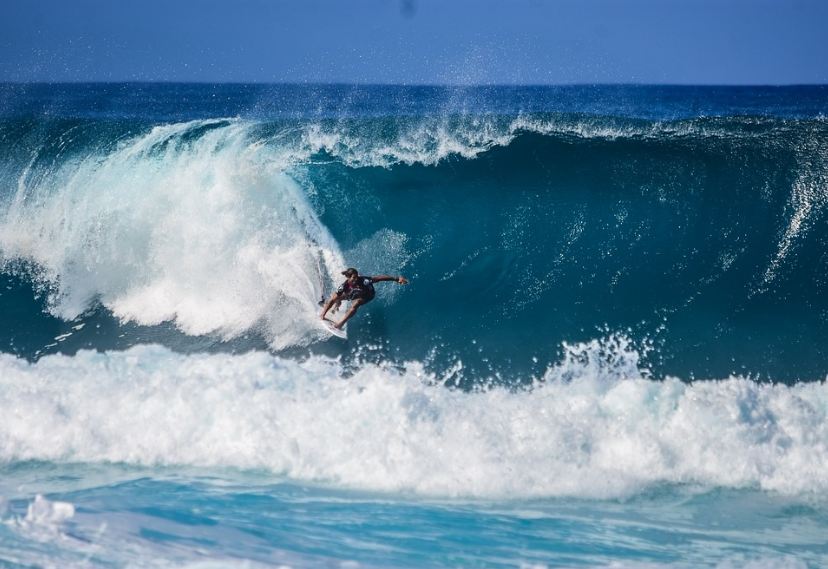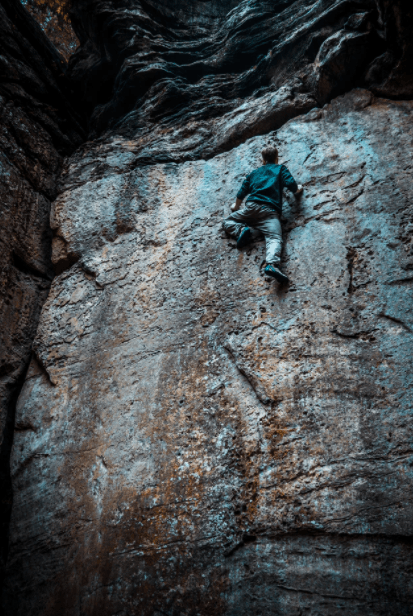What Equipment Is Used in Bungee Jumping?

Bungee jumping requires specialized equipment to ensure your safety and thrill. You'll need a strong, elastic bungee cord, a full-body harness or ankle straps, and sturdy carabiners to connect everything securely. Safety backups, like secondary cords or nets, provide extra protection. The jump platform, whether a bridge, tower, or crane, is crucial. Communication devices keep staff coordinated, while first aid equipment stands ready. Precise measurement tools help calculate the perfect cord length for your weight and jump height. With all these components working together, you're set for an exhilarating plunge. But there's more to discover about this high-flying adventure.
The Bungee Cord

At the heart of every bungee jumping experience lies the bungee cord. This essential piece of equipment is typically made from latex rubber or elastic materials, designed to stretch and recoil while absorbing the jumper's kinetic energy. You'll find that most bungee cords are composed of multiple strands woven together, creating a thick, durable rope capable of withstanding intense forces.
The cord's length and elasticity are carefully calculated based on factors such as the jump height, jumper's weight, and desired rebound effect. You'll notice that cords come in various diameters, usually ranging from 1 to 2 inches, with thicker cords providing more resistance and stability.
Safety is paramount, so bungee cords undergo rigorous testing and inspection before each use. They're regularly replaced to ensure optimal performance and prevent wear-induced failures. You'll often see redundant systems in place, with multiple cords or backup lines used for added security.
When you're connected to the bungee cord, you'll feel its gradual tension as you fall, followed by a smooth deceleration and exhilarating rebound. It's this controlled elasticity that makes bungee jumping both thrilling and relatively safe.
Harness Systems
How does a bungee jumper stay securely attached during their plunge? The answer lies in the harness system, a crucial piece of equipment that keeps you safely connected to the bungee cord. You'll typically wear a full-body harness that distributes the force of the jump across your body, reducing the risk of injury.
The harness consists of several components. There's a waist belt that sits snugly around your hips, leg loops that secure your thighs, and shoulder straps that help distribute the load. These parts are interconnected with sturdy webbing and reinforced stitching. You'll find multiple attachment points on the harness, usually at the waist and chest, where carabiners connect you to the bungee cord.
When choosing a harness, you'll want one that fits properly and is specifically designed for bungee jumping. It should be adjustable to ensure a snug fit, as a loose harness can cause discomfort or even compromise safety. Before your jump, an experienced operator will help you put on the harness and double-check all connections. Remember, a well-fitted, high-quality harness is essential for a safe and enjoyable bungee jumping experience.
Ankle Straps
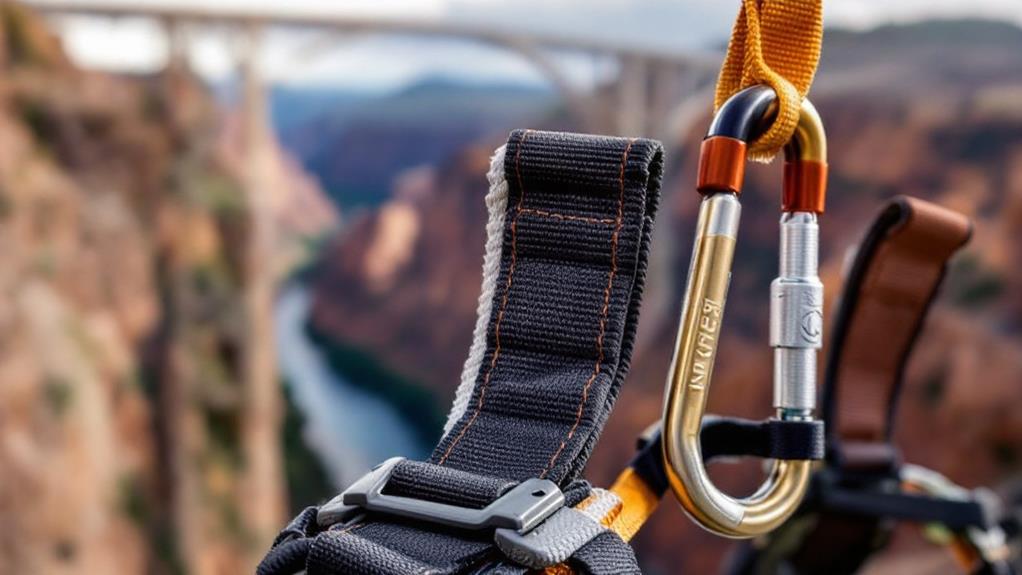
Strapping in for a different kind of thrill, some bungee jumpers opt for ankle attachments instead of a full-body harness. These ankle straps are designed to securely fasten around your ankles, connecting you to the bungee cords. They're typically made of strong, durable materials like nylon webbing or leather, reinforced with padding for comfort during the intense forces of the jump. Proper sizing, tension, and strength of the bungee cords are crucial for optimal performance and safety.
You'll find that ankle straps come in various designs, but most feature a wide, padded cuff that wraps around each ankle. They're secured with multiple fasteners, often including Velcro, buckles, and safety locks. The straps are connected to a central attachment point, where the bungee cord is linked.
When you're using ankle straps, it's crucial to ensure they're fitted correctly. They should be snug but not overly tight, allowing for proper circulation. Many jumpers prefer ankle straps for the unique sensation of falling headfirst, but they require more skill and aren't recommended for beginners. Always follow the guidance of experienced operators when using ankle straps, as proper attachment is critical for your safety during the jump.
Carabiners and Connectors
While bungee cords are the star of the show, carabiners and connectors play a crucial behind-the-scenes role in keeping you safely tethered during your jump. These small but mighty components are essential for linking various parts of your bungee jumping equipment together. The bungee cord is disposed of after 500-1000 jumps for safety, making these connection points all the more important.
Carabiners are strong, spring-loaded metal loops used to quickly and securely connect different elements of your gear. You'll find them attaching your harness to the bungee cord and connecting the cord to the jump platform. They're designed to withstand enormous amounts of force and feature a locking mechanism to prevent accidental openings.
Connectors, on the other hand, are broader terms for any devices that join two or more parts of your equipment. These can include quick links, shackles, and swivels. Each type serves a specific purpose, such as allowing for rotation or providing additional safety redundancy.
When you're preparing for your jump, you'll notice multiple carabiners and connectors being used throughout your setup. It's crucial to ensure that all these components are properly locked and secured before you take the plunge. Your jump master will double-check these connections, but it's always good to be aware of their importance in your safety system.
Safety Backups
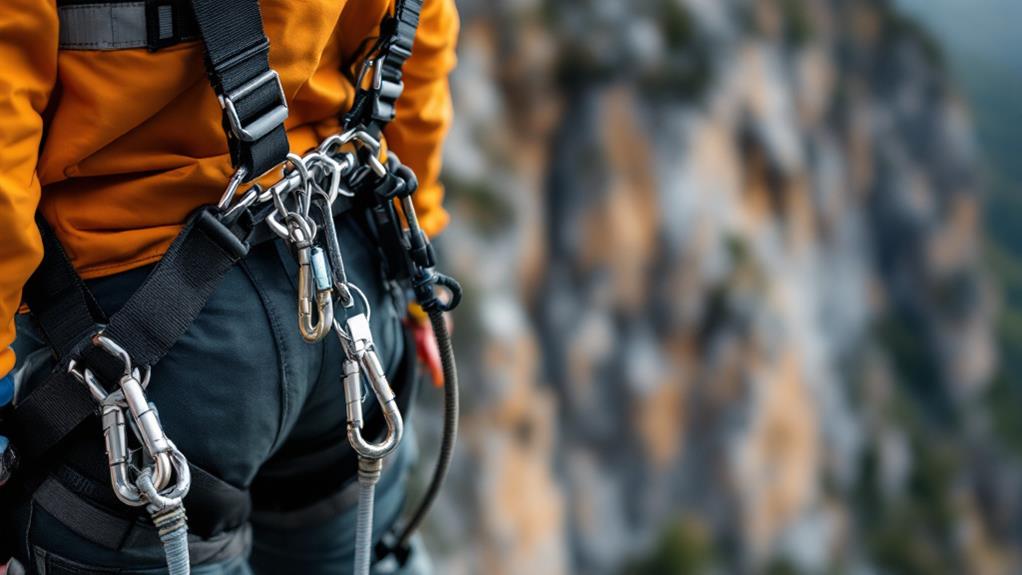
Safety backups are the unsung heroes of bungee jumping equipment. They're designed to provide an additional layer of protection in case your primary gear fails. You'll find redundant systems throughout a bungee setup, ensuring that if one component malfunctions, another is ready to take over.
One crucial safety backup is the secondary attachment point. This involves connecting your harness to the bungee cord using two separate points. If one fails, the other keeps you secure. You'll also encounter backup bungee cords, which are thinner cords running alongside the main one. They're there to support your weight if the primary cord snaps.
Safety nets are another common backup measure. Positioned below the jump site, they're ready to catch you if all else fails. Some operators use airbags instead of nets, serving the same purpose.
Don't forget about personnel backups. You'll always have multiple trained staff members overseeing your jump. They double-check each other's work and are prepared to intervene in emergencies. Remember, these safety backups aren't just formalities – they're essential components that make bungee jumping a thrilling yet controlled adventure.
Helmets for Protection
Helmets play a crucial role in safeguarding bungee jumpers from potential head injuries. When you're plummeting towards the ground at high speeds, your head needs protection from unexpected collisions or impacts. Bungee jumping helmets are specifically designed to be lightweight yet durable, ensuring they don't interfere with your jump while providing maximum protection.
You'll find that most bungee helmets are made from high-impact materials like polycarbonate or ABS plastic. These materials can absorb and distribute force effectively, reducing the risk of head trauma. The helmets often feature a comfortable inner lining and adjustable straps to ensure a snug fit, preventing them from shifting during your jump.
Some helmets come equipped with built-in visors or goggles to protect your eyes from wind, debris, or water splashes if you're jumping near bodies of water. It's essential to choose a helmet that's certified for bungee jumping and properly sized for your head. Remember, a well-fitting helmet can make the difference between a thrilling experience and a dangerous one, so don't skimp on this crucial piece of safety equipment.
Jump Platform or Structure

The jump platform or structure is the heart of any bungee jumping operation. It's the place where you'll take your leap of faith, so it needs to be sturdy, safe, and properly designed. You'll find various types of jump platforms, ranging from permanent structures to mobile cranes.
Permanent structures are often built on bridges, towers, or specially constructed platforms. These offer stability and can accommodate multiple jumpers. Mobile cranes, on the other hand, provide flexibility and can be set up in different locations.
Here's a quick overview of common jump platform types:
| Type | Advantages | Considerations |
|---|---|---|
| Bridge | Natural height, scenic views | Traffic management |
| Tower | Purpose-built, controlled environment | Construction costs |
| Crane | Portable, versatile | Setup time, wind sensitivity |
| Stadium | Large audience capacity | Event-specific use |
| Cliff | Natural thrill, unique experience | Safety measures, accessibility |
When you're at the jump site, you'll notice safety features like guardrails, secure footing, and a clear jump zone. The platform's height will determine the length of the bungee cord needed for your jump. Remember, a well-designed jump platform is crucial for your safety and overall bungee jumping experience.
Communication Devices
Reliable communication devices are essential for any bungee jumping operation. You'll find that these tools play a crucial role in ensuring safety and coordinating the jump. Most bungee sites use two-way radios or walkie-talkies to maintain constant contact between the jump master, ground crew, and other staff members. These devices allow for quick communication of important information, such as weather changes or equipment status updates.
In addition to radios, you might see staff using hand signals or flags to communicate visually, especially in noisy environments. Some advanced bungee operations even utilize wireless headsets with noise-canceling technology for clear communication in challenging conditions.
Here's why effective communication is vital in bungee jumping:
- Ensures jumper safety by allowing quick response to emergencies
- Facilitates smooth coordination between different team members
- Helps maintain a professional and organized atmosphere
First Aid Equipment
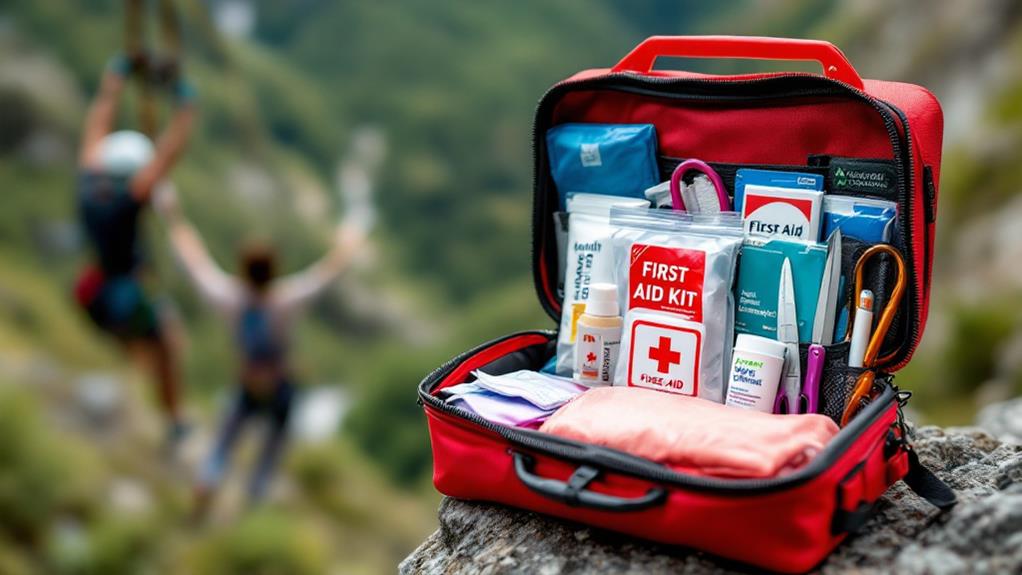
Safety-conscious bungee operators always keep a well-stocked first aid kit on hand. You'll find this essential equipment near the jumping platform, ready for immediate use if needed. The kit typically contains items to address common injuries or emergencies that might occur during bungee jumping.
Inside the first aid kit, you'll see bandages of various sizes, sterile gauze pads, and adhesive tape for treating minor cuts or abrasions. Antiseptic wipes and solutions are included to clean wounds and prevent infection. The kit also contains pain relievers, antihistamines, and anti-inflammatory medications to manage discomfort or allergic reactions.
You'll find scissors, tweezers, and safety pins for handling more complex situations. Elastic bandages and ice packs are available to treat sprains or reduce swelling. For more serious emergencies, the kit includes a CPR mask, disposable gloves, and a emergency blanket.
Many operators also keep an automated external defibrillator (AED) nearby, which can be crucial in case of cardiac emergencies. Remember, while first aid equipment is essential, it's always best to prioritize safety and follow all instructions to prevent accidents in the first place.
Measurement and Calculation Tools
Precision is paramount in bungee jumping, and that's where measurement and calculation tools come into play. You'll need accurate instruments to ensure your safety and the thrill of your jump. A high-quality digital scale is essential for measuring your exact weight, which is crucial for selecting the right bungee cord. You'll also use a laser distance meter to measure the jump height precisely, allowing for proper cord length calculations.
A bungee calculator is another vital tool you'll rely on. This specialized software or app takes into account various factors like your weight, jump height, and cord specifications to determine the optimal setup for your jump. It helps you calculate the right amount of stretch and ensures you'll experience the perfect bounce without hitting the ground or water below.
Don't forget these key points about measurement and calculation tools:
- They're critical for customizing each jump to the individual
- They help minimize risks by ensuring proper equipment selection
- They allow for consistent and repeatable jump experiences

